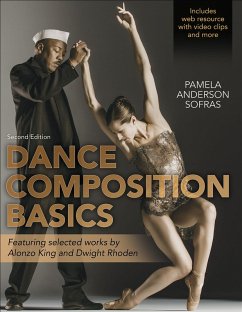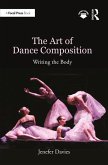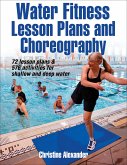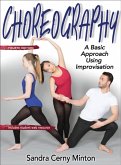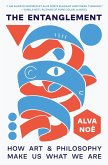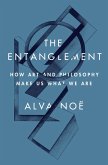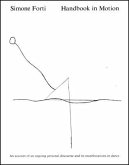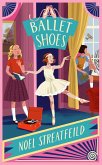Pamela Anderson Sofras
Dance Composition Basics-2nd Edition
Pamela Anderson Sofras
Dance Composition Basics-2nd Edition
- Broschiertes Buch
- Merkliste
- Auf die Merkliste
- Bewerten Bewerten
- Teilen
- Produkt teilen
- Produkterinnerung
- Produkterinnerung
Dance Composition Basics, Second Edition, featuring the works of Alonzo King and Dwight Rhoden, introduces dancers to choreography through problem-solving activities. The accompanying videos show King and Rhoden working with professional dancers. The book offers 27 lesson plans and many useful tools.
Andere Kunden interessierten sich auch für
![The Art of Dance Composition The Art of Dance Composition]() Jenefer DaviesThe Art of Dance Composition63,99 €
Jenefer DaviesThe Art of Dance Composition63,99 €![Water Fitness Lesson Plans and Choreography Water Fitness Lesson Plans and Choreography]() Christine AlexanderWater Fitness Lesson Plans and Choreography45,99 €
Christine AlexanderWater Fitness Lesson Plans and Choreography45,99 €![Choreography Choreography]() Sandra Cerny MintonChoreography43,99 €
Sandra Cerny MintonChoreography43,99 €![The Entanglement The Entanglement]() Alva NoeThe Entanglement23,99 €
Alva NoeThe Entanglement23,99 €![The Entanglement The Entanglement]() Alva NoeThe Entanglement21,99 €
Alva NoeThe Entanglement21,99 €![Handbook in Motion: An Account of an Ongoing Personal Discourse and Its Manifestations in Dance Handbook in Motion: An Account of an Ongoing Personal Discourse and Its Manifestations in Dance]() Simone FortiHandbook in Motion: An Account of an Ongoing Personal Discourse and Its Manifestations in Dance20,99 €
Simone FortiHandbook in Motion: An Account of an Ongoing Personal Discourse and Its Manifestations in Dance20,99 €![Ballet Shoes Ballet Shoes]() Noel StreatfeildBallet Shoes19,99 €
Noel StreatfeildBallet Shoes19,99 €-
-
-
Dance Composition Basics, Second Edition, featuring the works of Alonzo King and Dwight Rhoden, introduces dancers to choreography through problem-solving activities. The accompanying videos show King and Rhoden working with professional dancers. The book offers 27 lesson plans and many useful tools.
Produktdetails
- Produktdetails
- Verlag: Human Kinetics Publishers
- 2 ed
- Seitenzahl: 176
- Erscheinungstermin: 27. März 2019
- Englisch
- Abmessung: 274mm x 214mm x 10mm
- Gewicht: 594g
- ISBN-13: 9781492571254
- ISBN-10: 1492571253
- Artikelnr.: 55121828
- Herstellerkennzeichnung
- Libri GmbH
- Europaallee 1
- 36244 Bad Hersfeld
- gpsr@libri.de
- Verlag: Human Kinetics Publishers
- 2 ed
- Seitenzahl: 176
- Erscheinungstermin: 27. März 2019
- Englisch
- Abmessung: 274mm x 214mm x 10mm
- Gewicht: 594g
- ISBN-13: 9781492571254
- ISBN-10: 1492571253
- Artikelnr.: 55121828
- Herstellerkennzeichnung
- Libri GmbH
- Europaallee 1
- 36244 Bad Hersfeld
- gpsr@libri.de
Pamela Anderson Sofras, MEd, is a professor emerita of dance and dance education and was the first chair of the dance department in the College of Arts and Architecture at the University of North Carolina (UNC) at Charlotte. She has 34 years of experience teaching dance at the university level and has taught and developed courses in modern dance technique, composition, and dance education methods. From 1978 to 1990, she was affiliated with the American Dance Festival as a faculty member. She served as assistant, associate dean, and founding director of the American Dance Festival’s School for Young Dancers. Sofras was part of a team of educators who wrote dance education guidelines for training K-12 dance teachers for North Carolina public schools. She has also developed curriculum materials, supported by state and national grants, for professional arts organizations in New Jersey, North Carolina, Tennessee, and New York. Sofras has been the recipient of six North Carolina Arts Council grant awards to study the choreographic processes of five choreographers as they created works for a professional dance company. The processes were documented and translated into curriculum materials for teachers and for university classes. A charter member of the National Dance Education Organization (NDEO), Sofras has also been curriculum consultant for North Carolina Dance Theatre (currently the Charlotte Ballet) and a site evaluator for the North Carolina Arts Council grant activities. She has received numerous awards for her contributions to the field of dance education, including the NDEO’s Vision Award; the American Alliance for Health, Physical Education, Recreation and Dance (AAHPERD) College/University Educator of the Year; and the North Carolina Dance Alliance Award. In addition, she received the UNC Service Award in 2002 for her sustained service to public schools. Sofras regularly presents professional development workshops in dance pedagogy for teaching artists and teachers working in public and private schools. Most recently, she has worked with Ballet Met in Columbus, Ohio, and the Alabama Institute for Education in the Arts. She serves as a member of the education committee of the Charlotte Ballet in Charlotte, North Carolina.
Chapter 1. The Body: Exploring the Ways We Move
Lesson 1 Impulse: Origins of Movement
Lesson 2 Phrase: Linking Movements
Lesson 3 Gesture: Personal Vocabulary of Movement
Lesson 4 Shape: Body Design
Lesson 5 Problem Solving: Creating a Solo
Chapter 2. Space: Exploring the Expanse We Move In
Lesson 1 Air and Floor Pathways: Mapping the Route
Lesson 2 Diagonals: From Corner to Corner
Lesson 3 Symmetry: Balancing Shapes
Lesson 4 Positive and Negative Space: Sharing a Shape
Lesson 5 Balance: Supporting Each Other
Lesson 6 Imitation: Reflecting Each Other
Lesson 7 Problem Solving: Creating a Duet
Chapter 3. Time: Exploring Tempo
Lesson 1 Slow Motion: Dancing in Reverie
Lesson 2 Speed: Learning to Dance Quickly
Lesson 3 Pacing: Combining Different Pulses
Lesson 4 Accelerating: How Fast Can It Go?
Lesson 5 Problem Solving: Creating a Trio
Chapter 4. Energy: Force Generating Movement
Lesson 1 Inertia: Readiness to Move
Lesson 2 Opposites: Contrasting Energies
Lesson 3 Dynamics: Qualities of Movement
Lesson 4 Intensity: Increasing and Decreasing Force
Lesson 5 Problem Solving: Creating a Small-Group Composition
Chapter 5. Choreographic Devices: Creating Finished Compositions
Lesson 1 Call and Response: Antiphonal Movement
Lesson 2 Canon: Dancing in Unison a Few Counts Apart
Lesson 3 Directional Mirroring: Parallel Reflecting and Reverse Reflecting
Lesson 4 Variation: Interweaving and Varying Patterns
Lesson 5 Problem Solving: Creating a Movement Suite
Lesson 1 Impulse: Origins of Movement
Lesson 2 Phrase: Linking Movements
Lesson 3 Gesture: Personal Vocabulary of Movement
Lesson 4 Shape: Body Design
Lesson 5 Problem Solving: Creating a Solo
Chapter 2. Space: Exploring the Expanse We Move In
Lesson 1 Air and Floor Pathways: Mapping the Route
Lesson 2 Diagonals: From Corner to Corner
Lesson 3 Symmetry: Balancing Shapes
Lesson 4 Positive and Negative Space: Sharing a Shape
Lesson 5 Balance: Supporting Each Other
Lesson 6 Imitation: Reflecting Each Other
Lesson 7 Problem Solving: Creating a Duet
Chapter 3. Time: Exploring Tempo
Lesson 1 Slow Motion: Dancing in Reverie
Lesson 2 Speed: Learning to Dance Quickly
Lesson 3 Pacing: Combining Different Pulses
Lesson 4 Accelerating: How Fast Can It Go?
Lesson 5 Problem Solving: Creating a Trio
Chapter 4. Energy: Force Generating Movement
Lesson 1 Inertia: Readiness to Move
Lesson 2 Opposites: Contrasting Energies
Lesson 3 Dynamics: Qualities of Movement
Lesson 4 Intensity: Increasing and Decreasing Force
Lesson 5 Problem Solving: Creating a Small-Group Composition
Chapter 5. Choreographic Devices: Creating Finished Compositions
Lesson 1 Call and Response: Antiphonal Movement
Lesson 2 Canon: Dancing in Unison a Few Counts Apart
Lesson 3 Directional Mirroring: Parallel Reflecting and Reverse Reflecting
Lesson 4 Variation: Interweaving and Varying Patterns
Lesson 5 Problem Solving: Creating a Movement Suite
Chapter 1. The Body: Exploring the Ways We Move
Lesson 1 Impulse: Origins of Movement
Lesson 2 Phrase: Linking Movements
Lesson 3 Gesture: Personal Vocabulary of Movement
Lesson 4 Shape: Body Design
Lesson 5 Problem Solving: Creating a Solo
Chapter 2. Space: Exploring the Expanse We Move In
Lesson 1 Air and Floor Pathways: Mapping the Route
Lesson 2 Diagonals: From Corner to Corner
Lesson 3 Symmetry: Balancing Shapes
Lesson 4 Positive and Negative Space: Sharing a Shape
Lesson 5 Balance: Supporting Each Other
Lesson 6 Imitation: Reflecting Each Other
Lesson 7 Problem Solving: Creating a Duet
Chapter 3. Time: Exploring Tempo
Lesson 1 Slow Motion: Dancing in Reverie
Lesson 2 Speed: Learning to Dance Quickly
Lesson 3 Pacing: Combining Different Pulses
Lesson 4 Accelerating: How Fast Can It Go?
Lesson 5 Problem Solving: Creating a Trio
Chapter 4. Energy: Force Generating Movement
Lesson 1 Inertia: Readiness to Move
Lesson 2 Opposites: Contrasting Energies
Lesson 3 Dynamics: Qualities of Movement
Lesson 4 Intensity: Increasing and Decreasing Force
Lesson 5 Problem Solving: Creating a Small-Group Composition
Chapter 5. Choreographic Devices: Creating Finished Compositions
Lesson 1 Call and Response: Antiphonal Movement
Lesson 2 Canon: Dancing in Unison a Few Counts Apart
Lesson 3 Directional Mirroring: Parallel Reflecting and Reverse Reflecting
Lesson 4 Variation: Interweaving and Varying Patterns
Lesson 5 Problem Solving: Creating a Movement Suite
Lesson 1 Impulse: Origins of Movement
Lesson 2 Phrase: Linking Movements
Lesson 3 Gesture: Personal Vocabulary of Movement
Lesson 4 Shape: Body Design
Lesson 5 Problem Solving: Creating a Solo
Chapter 2. Space: Exploring the Expanse We Move In
Lesson 1 Air and Floor Pathways: Mapping the Route
Lesson 2 Diagonals: From Corner to Corner
Lesson 3 Symmetry: Balancing Shapes
Lesson 4 Positive and Negative Space: Sharing a Shape
Lesson 5 Balance: Supporting Each Other
Lesson 6 Imitation: Reflecting Each Other
Lesson 7 Problem Solving: Creating a Duet
Chapter 3. Time: Exploring Tempo
Lesson 1 Slow Motion: Dancing in Reverie
Lesson 2 Speed: Learning to Dance Quickly
Lesson 3 Pacing: Combining Different Pulses
Lesson 4 Accelerating: How Fast Can It Go?
Lesson 5 Problem Solving: Creating a Trio
Chapter 4. Energy: Force Generating Movement
Lesson 1 Inertia: Readiness to Move
Lesson 2 Opposites: Contrasting Energies
Lesson 3 Dynamics: Qualities of Movement
Lesson 4 Intensity: Increasing and Decreasing Force
Lesson 5 Problem Solving: Creating a Small-Group Composition
Chapter 5. Choreographic Devices: Creating Finished Compositions
Lesson 1 Call and Response: Antiphonal Movement
Lesson 2 Canon: Dancing in Unison a Few Counts Apart
Lesson 3 Directional Mirroring: Parallel Reflecting and Reverse Reflecting
Lesson 4 Variation: Interweaving and Varying Patterns
Lesson 5 Problem Solving: Creating a Movement Suite

